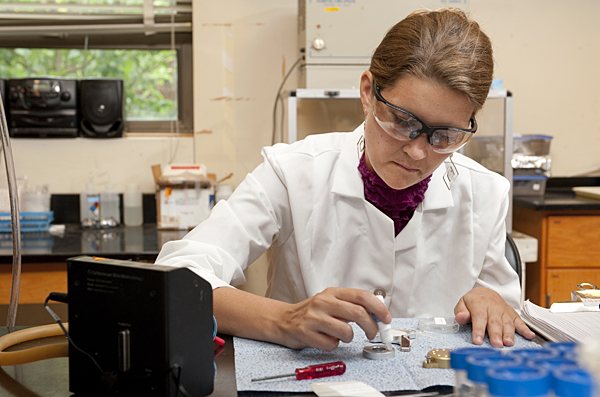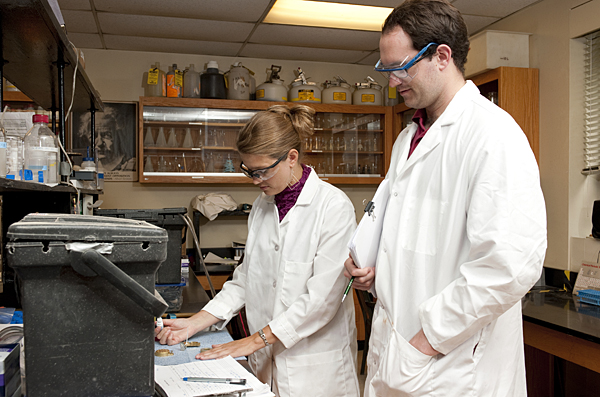


An ultra-bright future
UD grad students benefit from research at national laboratories
8:13 a.m., July 12, 2011--Graduate students in soil and environmental chemistry at the University of Delaware have logged an unusual record of success in gaining access to some of the most advanced scientific equipment in the world at national laboratories around the country.
That access has been a key learning experience and a top selling point when the students graduate and head into the job market, according to Donald Sparks, S. Hallock du Pont Chair of Plant and Soil Sciences and director of the Delaware Environmental Institute.
Research Stories
Chronic wounds
Prof. Heck's legacy
Sparks has been instrumental in building the soil science program at UD and has served as an adviser to 52 graduate students and 25 postdoctoral researchers in soil and environmental chemistry. With his mentorship, students in his research group have frequently traveled to a number of national labs including Brookhaven, Lawrence-Berkeley, and Argonne, as well as the Stanford Synchrotron Radiation Laboratory, the Swiss Light Source, and the Canadian Light Source.
According to Sparks, a major asset attracting researchers to the national labs is the synchrotron light source. A synchrotron produces ultra-bright light by circulating electrons at nearly the speed of light. Exceedingly bright x-rays, termed “beamlines,” produced by the circulating electrons allow users to determine the forms of metals and nutrients in soil and other natural materials at the molecular level.
“One of the major reasons that most synchrotron-based techniques are ideal for natural materials such as soils, plants and particulates is that you can study them in their natural state—that is, with water present. They don’t have to be dried or placed under high vacuum, which can cause experimental artifacts,” says Sparks.
Many of the national labs are supported by the U.S. Department of Energy (DOE), and provide users with equipment and techniques that are indispensable to their research. Access to the equipment is a highly competitive process. Users must submit a written proposal describing the planned research, which is reviewed by a scientific committee that makes recommendations about which projects should be scheduled at the lab. Many researchers get only a few days each year to complete their work at the facilities.
While there is no charge for researchers to use the synchrotron once approved, there are travel, lodging and food expenses incurred in a trip to the one of the labs. The Delaware Experimental Program to Stimulate Competitive Research (EPSCoR) has been a source of funds to cover these expenses for Delaware students. Delaware EPSCoR has also contributed funds for the development of a beamline at Brookhaven National Lab that is specific for elements such as phosphorus and sulfur. Such capability is useful to UD students who are conducting research associated with nutrient management and water quality, key environmental issues in Delaware.
Grad students share their experiences
Matt Siebecker has been a Ph.D. graduate student in environmental soil chemistry for four years, while Shannon Carter has been a member of the Sparks research group for less than a year. Both have conducted studies at the National Synchrotron Light Source at Brookhaven National Lab (located in Upton, N.Y., on Long Island), while Siebecker has spent time at Stanford Synchrotron Radiation Laboratory at Stanford University as well.
Siebecker hopes that his research may someday be applied to cleaning up soils contaminated by pollutants, especially metals. In order to understand how metals are sequestered in soils, Siebecker must first determine the chemical form of the metal. This is where the synchrotron light source becomes essential. Siebecker calls the synchrotron an indispensable part of his research.
Siebecker says that having the chance to work in a national lab has really opened his eyes to a larger picture of science, as these labs draw scientists from a vast array of fields.
“When I came to UD in 2007, I hadn’t really done a whole lot of research. I didn’t know what types of instruments and techniques were out there,” he says. “But Dr. Sparks has done a lot of great research and has been able to help us get time at these national labs. This allows us to learn some of the most advanced techniques that are available and apply them to our research.”
Carter got her undergraduate degree at Wesley College in Dover, Del. She studied under Malcolm D’Souza, a chemistry professor affiliated with the Delaware EPSCoR program, which endeavors to create a smooth pathway for advancement of Delaware students interested in science and engineering fields.
Her current research focuses on determining the form and distribution of metals and metalloids associated with particulate matter emitted from poultry houses. Breathing particulates that could have metals such as arsenic and copper associated with them may pose a health hazard to workers in poultry houses.
Using synchrotron spectroscopy, Carter is able to determine the forms, or species, of metals in her samples—a necessary step in order to determine the metal’s toxicity. Because her research depends so fully on the data provided by the synchrotron, Carter referred to her first visit to Brookhaven as “a defining moment.”
She refers to working in the national lab as an intensive but rewarding experience. Due to the high demand for the synchrotron technique, users must plan their experiments carefully because they may not receive additional time to re-do them if the collected data are not usable. Researchers work around the clock to complete their experiments.
“I come from a biology background,” she says. “When I joined the group, I didn’t know anything about synchrotron spectroscopy. Now I’m comfortable using a couple of different applications. Micro-x-ray fluorescent mapping, for example, provides detailed maps of elemental distribution and association in natural systems—plus, it’s fun because it’s a very colorful way to visualize the particles of different metals.”
Life after graduation
Despite the grueling process of gaining access and completing their experiments, graduate students reap the benefits of doing research in the national labs. Just learning about the application process is educational in itself, and once experienced, the knowledge of how to use state-of-the-art equipment makes graduate students more competitive in the job market and creates opportunities to network.
Jen Seiter, a former student of Sparks, currently works as a research physical scientist with the U.S. Army Corps of Engineers at the Engineer Research and Development Center in Vicksburg, Miss.
“As a former member of Dr. Sparks' research group, I was privileged to travel to Brookhaven, Argonne and Lawrence-Berkeley National Laboratories,” says Seiter. “Today, I conduct environmental research using the skill set that I developed while working at the national laboratories in graduate school. I am very grateful to have a stable and exciting job doing exactly what I was trained to do.”
UD alumnus Ryan Tappero agrees that his experience working with the synchrotron as a graduate student was very influential in his career. “I gained valuable experience and made important contacts that ultimately influenced my decision to pursue a career a career at a synchrotron facility at a national laboratory,” he says. He is now employed as a beamline scientist at Brookhaven National Laboratory.
In addition to Tappero, 23 of Sparks’ former research group members, who are employed at universities, institutes and the national labs themselves, are conducting research at synchrotron facilities on four continents. The experience they gained while at UD has definitely paid off in their careers.
Article by Kate Sadowski and Beth Chajes
Photos by Kathy F. Atkinson










